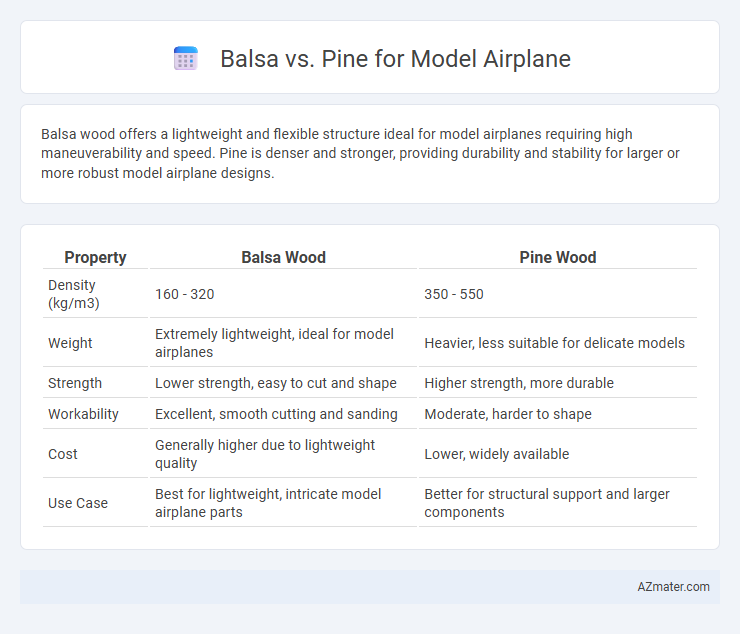Balsa wood offers a lightweight and flexible structure ideal for model airplanes requiring high maneuverability and speed. Pine is denser and stronger, providing durability and stability for larger or more robust model airplane designs.
Table of Comparison
| Property | Balsa Wood | Pine Wood |
|---|---|---|
| Density (kg/m3) | 160 - 320 | 350 - 550 |
| Weight | Extremely lightweight, ideal for model airplanes | Heavier, less suitable for delicate models |
| Strength | Lower strength, easy to cut and shape | Higher strength, more durable |
| Workability | Excellent, smooth cutting and sanding | Moderate, harder to shape |
| Cost | Generally higher due to lightweight quality | Lower, widely available |
| Use Case | Best for lightweight, intricate model airplane parts | Better for structural support and larger components |
Introduction to Balsa and Pine for Model Airplanes
Balsa wood is renowned for its exceptional lightness and strength-to-weight ratio, making it a preferred choice for model airplane construction where weight reduction is crucial for flight performance. Pine, while heavier and denser than balsa, offers greater rigidity and durability, which can be advantageous for structural components requiring enhanced stability. Both woods serve distinct roles in model aircraft design, with balsa favored for wing and fuselage frameworks, and pine utilized for reinforcing parts and areas subjected to higher stress.
Material Properties: Balsa vs Pine
Balsa wood offers an exceptional strength-to-weight ratio with a density typically around 160 kg/m3, making it ideal for lightweight model airplanes requiring high maneuverability. Pine, denser at approximately 500 kg/m3, provides greater structural durability but adds significant weight, impacting flight performance and agility. The softness and easily workable grain of balsa enable precise shaping and sanding, while pine's harder texture demands more effort but yields sturdier frames.
Weight Comparison: Which is Lighter?
Balsa wood is significantly lighter than pine, making it the preferred choice for model airplane construction where minimizing weight is critical for flight performance. The average density of balsa ranges from 100 to 200 kg/m3, while pine typically has a density between 350 and 550 kg/m3, resulting in a substantial weight difference. This lower density of balsa allows model builders to achieve better lift and maneuverability without compromising structural integrity.
Strength and Durability Differences
Balsa wood offers exceptional lightweight properties ideal for model airplane construction but lacks the strength and durability found in pine, making it more prone to dents and breakage under stress. Pine is denser and stronger, providing greater resistance to impact and wear, which enhances the model's longevity, especially in rough handling or crash scenarios. Choosing between balsa and pine depends on balancing the need for lightness with the desire for a sturdier, more durable structure.
Workability and Ease of Shaping
Balsa wood offers superior workability and ease of shaping due to its lightweight and soft grain, making it the preferred choice for intricate model airplane parts that require detailed sanding and carving. Pine, being denser and harder, is more challenging to shape and may require specialized tools, but it provides greater structural strength for larger or load-bearing components. Model builders often choose balsa for its flexibility in crafting aerodynamic shapes, while pine is selected when durability and rigidity are prioritized.
Cost and Availability of Balsa and Pine
Balsa wood is widely favored for model airplanes due to its lightweight properties, but it tends to be more expensive and less readily available compared to pine. Pine is generally cheaper and easier to source in larger quantities, making it a cost-effective alternative for hobbyists on a budget. While pine is heavier and denser, its availability in various sizes and lower price point often compensates for its added weight in model construction.
Flight Performance: Impact on Model Airplanes
Balsa wood enhances flight performance in model airplanes due to its lightweight structure, providing better lift and longer flight duration compared to pine. Pine's higher density can increase durability but often results in reduced maneuverability and shorter glide times. Choosing balsa maximizes agility and efficiency, critical for competitive and precision flying models.
Suitability for Beginners vs Experienced Builders
Balsa wood is highly suitable for beginner model airplane builders due to its lightweight, ease of cutting, and forgiving nature during assembly. Pine, being denser and stronger, is preferred by experienced builders seeking durability and structural integrity for advanced or larger models. The choice between balsa and pine depends on the builder's skill level, project complexity, and desired balance between lightness and strength.
Environmental Impact and Sustainability Considerations
Balsa wood is highly popular in model airplanes due to its rapid growth and renewable nature, making it a sustainable choice with a low environmental impact. Pine, while also renewable, grows slower and often requires more intensive forestry management, which can lead to greater carbon emissions and habitat disruption. Choosing balsa supports eco-friendly modeling by promoting sustainable harvesting practices and minimizing ecological footprints.
Conclusion: Choosing the Best Wood for Your Model Airplane
Balsa wood offers unmatched lightness and ease of shaping, making it the preferred choice for model airplane enthusiasts focused on flight performance and detailed craftsmanship. Pine, while sturdier and more affordable, often compromises on weight and flexibility, which can affect the aircraft's aerodynamics and handling. Selecting between balsa and pine hinges on balancing weight sensitivity with durability requirements to optimize your model airplane's flight capabilities.

Infographic: Balsa vs Pine for Model Airplane
 azmater.com
azmater.com